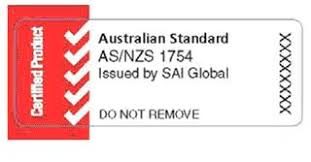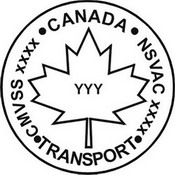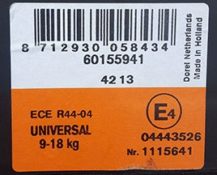Occasionally, caregivers arrive at checkup stations or events with a CR that was not made for our market and/or is lacking labels that say it is approved for use here. In this situation, what should a CPST do?
Although it is true that CRs that don’t meet FMVSS 213 should not be used in the U.S., the answer about how to proceed with the checkup depends on the answers to some questions:
- Is the seat an actual CR, approved for use in another country, or is it just an untested seating device?
- Are the caregivers just visiting, or are they living here for a long or indefinite period of time?
- Is a baby already using the CR, or was the CR purchased for a baby on the way?
Non-CR Seating Devices
It’s important to determine the answer to the first question because it is extremely dangerous for a child to be transported in a seating device that has not been designed and tested to protect an occupant in a crash. If a child is seen riding in a seat that is not a real CR in any country with standards, the caregiver should be educated about the serious risks to the child and told that they are breaking state laws that are intended to keep their child safe. They should be instructed to acquire a new CR right away. If a child is currently using the seat, the agency conducting the checkup would ideally provide a new CR on the spot, whenever possible.
Although it is not a CPST’s job to confiscate CRs, effort should be taken to prevent a phony CR from being used, including strongly urging the caregiver to abandon the seat and taking the seat off their hands, if it’s offered. CPSTs should also gather information and take photos that can be used to identify the device when contacting authorities (scroll to bottom of page).
Foreign CRs
If, on the other hand, the CR is approved for use in a foreign country, then it has been designed and tested to protect a child in a crash, but does not meet the particular standards of our country. Outside the U.S., safety standards have been created for CRs in Canada, Europe, and Australia/New Zealand. Most other countries that don’t maintain their own set of standards designate the standards of one or more of these areas as the ones that must be met for CRs used there. The images here are examples of the labels used to indicate that a CR has met the dynamic crash standards of another country. If a CR doesn’t have the U.S. label for meeting FMVSS 213 or one of these other labels, it is probably not a valid child restraint.
CPSTs and caregivers often ask which country has the “best” standards, and while the details of standards certainly vary (as do global approaches to CPS in general), it is impossible to say that one is better than another. So, if a caregiver is using a CR acquired in their home country, it is very possible that the CR is a safe one for use there.
However, that is not to say that it is okay to use foreign CRs here. Although NHTSA does not have an official statement regarding the use of American CRs only, every state has a child occupant protection law that requires the use of a federally approved CR, so only CRs with labeling that states it meets FMVSS 213 are legal.
There are several reasons for this. Law enforcement officers must be able to determine proper usage when enforcing local laws, and limiting the CRs in use to those legitimately on the U.S. market is essential. Labels must be legible—in English—in order to be able to determine proper use, and features must resemble those familiar in the North American market (like the uniform presence of harness retainer clips, which are not part of CRs elsewhere in the world).
Another reason is the lack of recall recourse. Only CRs made for the U.S. market are monitored here for recalls and can be registered for recall notification. It would be difficult to verify whether a CR made for another market has been recalled.
Therefore, when educating a family that is using a foreign CR, it’s important to use tact. Although a CPST is right to be concerned about use of a CR that is technically illegal, the goal should always be to maintain the right atmosphere for learning. Acknowledge that the CR may meet standards elsewhere, and its use during a brief stay in the U.S. would probably not violate most state laws. However, if the family is living here for an extended period of time (and who would come to a checkup event while on vacation?), tell them that state law requires use of CRs that are labeled as meeting the standards of the U.S. While this doesn’t automatically mean that their CR is not a safe one, it does mean that all caregivers living in the U.S. are expected to conform to the laws established here to keep children safe. In a traffic stop, they would be at risk of getting a ticket for using a noncompliant CR.
Also, while many foreign CRs seen in the U.S. were bought abroad and came along with caregivers when they moved here, if instead the CR was purchased from an international website and delivered to a U.S. address, that should be reported (scroll to bottom of page). NHTSA wants to know about this type of commerce that brings CRs that fail to meet FMVSS 213 to the U.S. Rest assured that any NHTSA follow-up would be with the seller and would not get the caregiver into trouble.
Educating Caregivers Who Have Non-U.S. CRs
After giving these warnings, if an appropriate CR is not provided by the sponsoring agency, and a child is already using this CR (at least until a new one can be purchased), in most cases it is best to continue the checkup so the caregiver is educated to the best of the CPST’s ability. Although it must be made clear to the caregivers that such help with a non-U.S. CR does not condone its use, it is important to ensure that children leave an event as safely as possible—even if that is only for the ride to the nearest retailer to buy another CR. If the country of origin has provided labels/instructions in English, it is likely that U.S.-trained CSPTs will be able to assist in proper usage. Even if the text language isn’t English, most European CRs have very detailed graphic instructions that are provided to bridge the anticipated language gap (since European models are expected to be sold to consumers living in many different countries).
On the other hand, if the child isn’t present or has not yet been born, the caregiver should have some time to acquire an allowable CR before needing to use one. In this case, if the agency has a sample CR on hand, consider teaching the basics using that model instead. In particular, point out features like the NHTSA labels and the recall postcard that are reasons to use a domestic model.
Bottom line: The next step of acquiring a safe and appropriate CR will be the responsibility of the caregiver, so a CPST’s goal is to convincingly explain why this is important and prepare them to be able to use their new CR properly. If appropriate, report concerns to the government using the information at the bottom of this page.
In the U.S.
NHTSA does not currently have official guidance regarding use of non-U.S. CRs, but the agency says that may change in the future. NHTSA let SRN know that CPSTs with concerns about any CR should contact the agency.
Regarding foreign CRs purchased/shipped here, contact:
Larry Herschman
NHTSA, Office of Defects Investigation
202-366-4929
Larry.Herschman@dot.gov
Regarding seats suspected of noncompliance with FMVSS 213, contact:
Zachary R. Fraser
Senior Safety Compliance Engineer
NHTSA, U.S. Department of Transportation
202-366-5754
Zack.Fraser@dot.gov
In Canada
CRs must meet applicable Canada Motor Vehicle Safety Standards (CMVSSs). Transport Canada, NHTSA’s Canadian counterpart, has posted a statement about use of CRs that are noncompliant with its regulations, warning citizens (retailers and caregivers alike) that it is illegal to import and use foreign CRs.
CR defects and concerns in Canada may be addressed online or by calling 1-800-333-0510.



